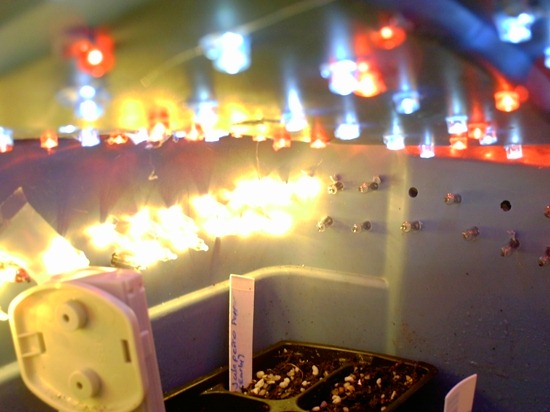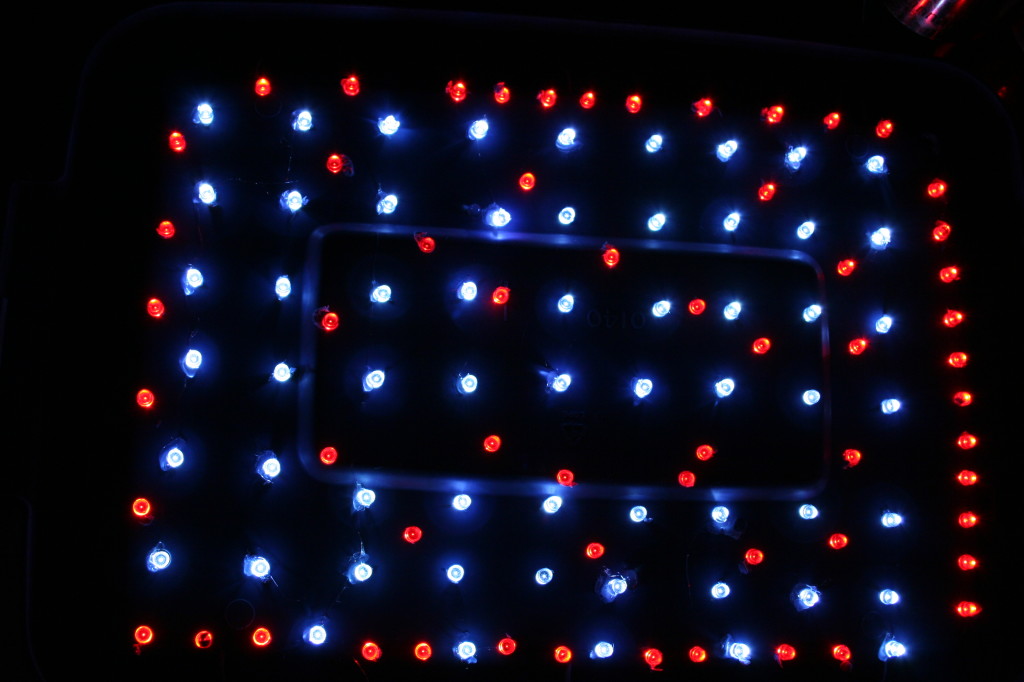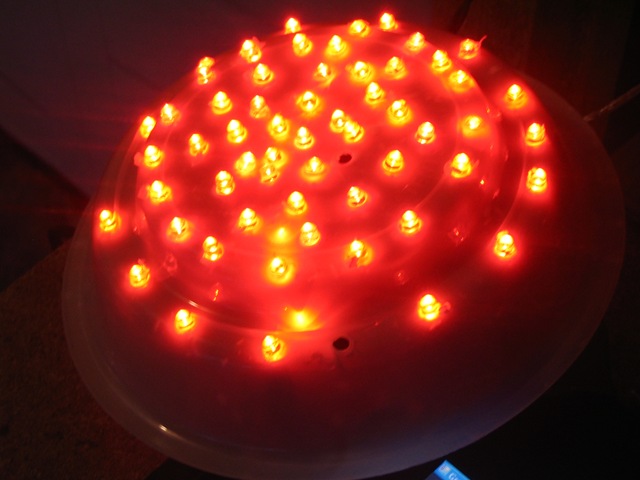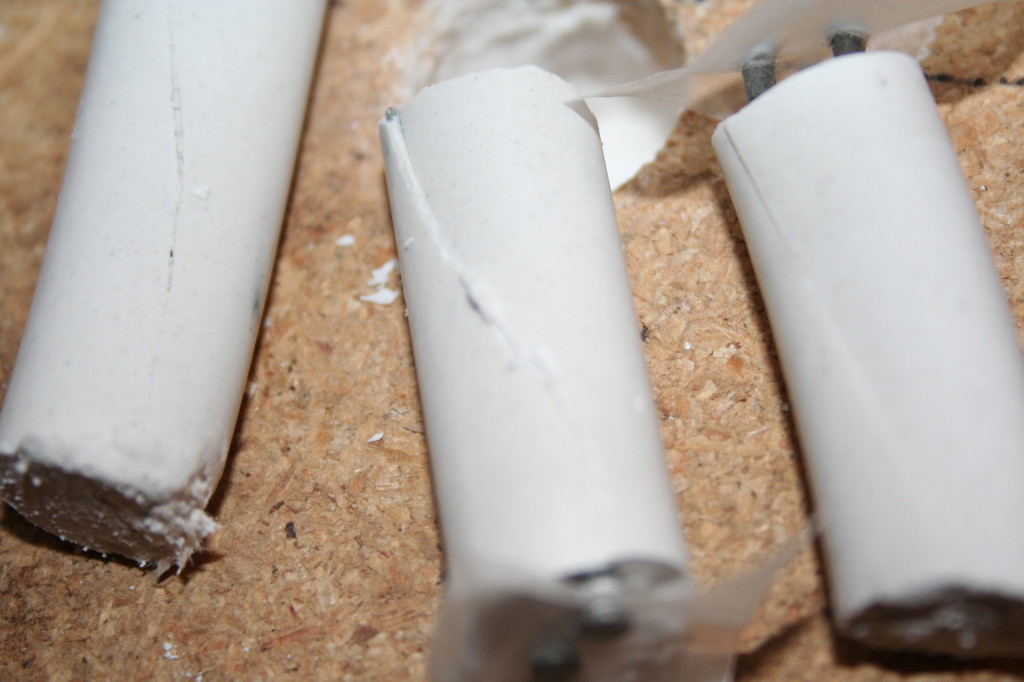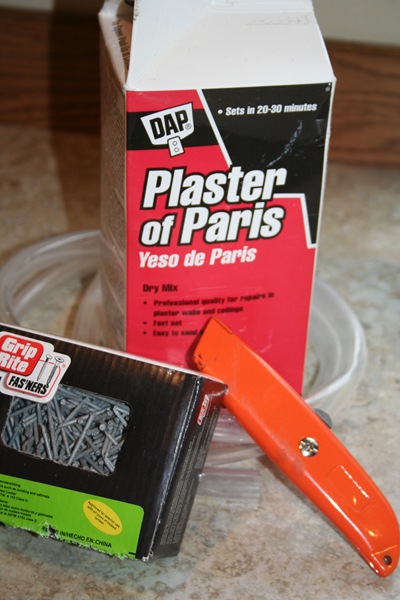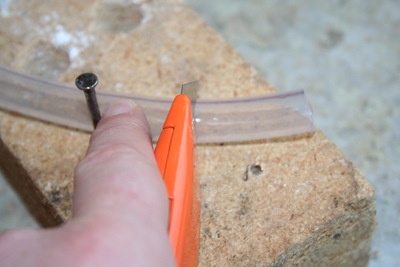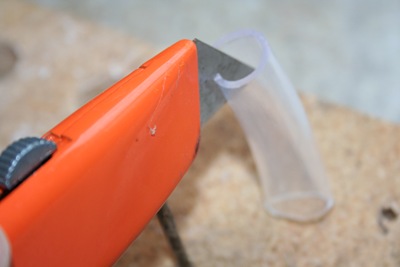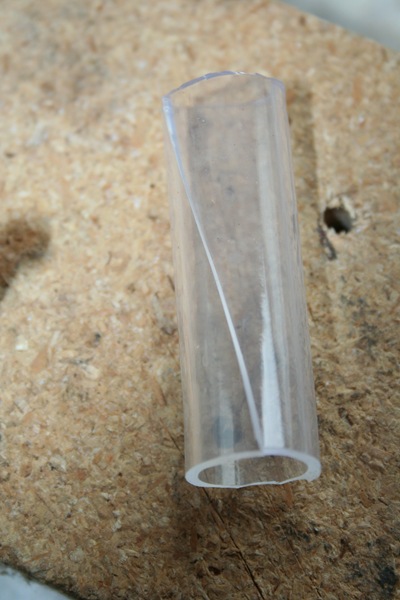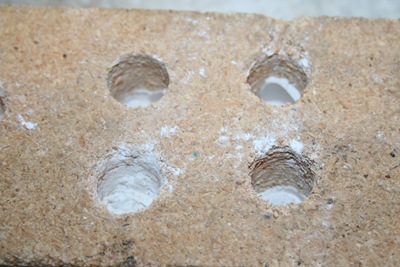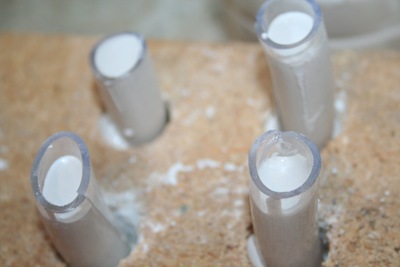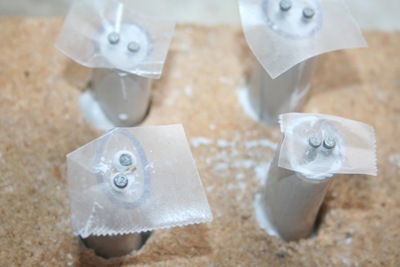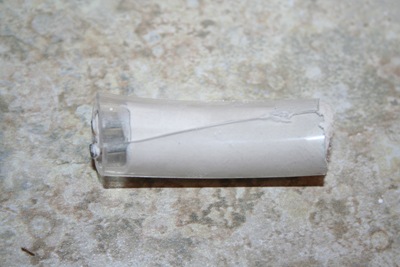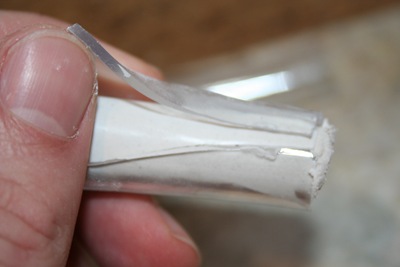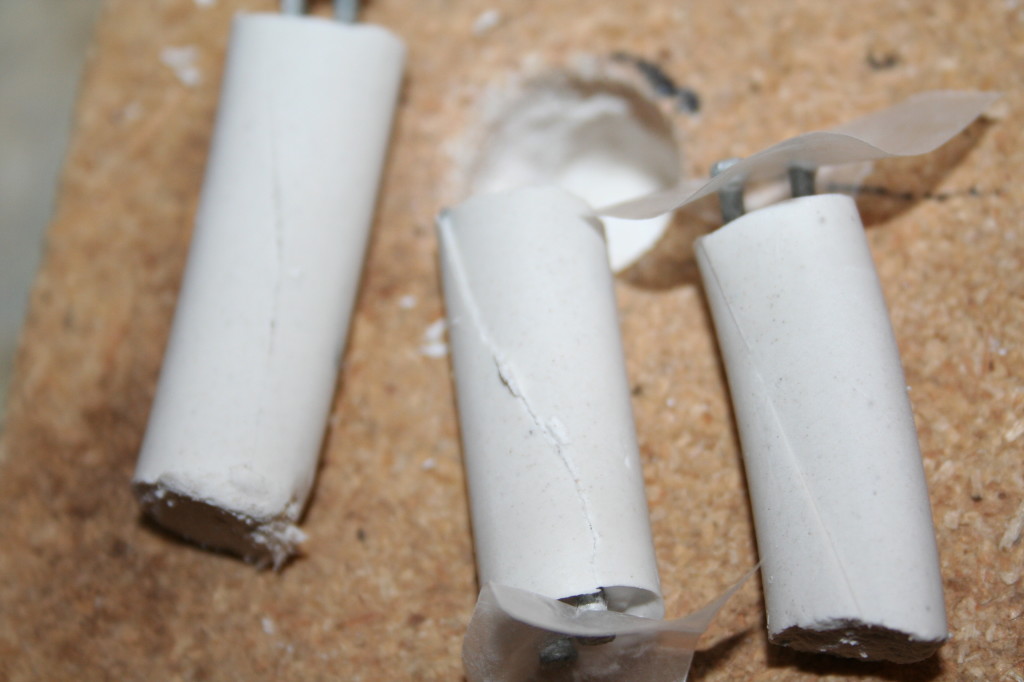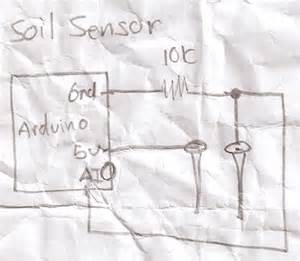LED grow box gets an upgrade
14.3 years ago cheap, indoor growbox, indoor seed starting, LEDs, seeds
In our family we are not just cheap in the garden we also keep our house pretty cool to save on heating costs. Unfortunately since the LEDs in my grow box do not put out very much heat the inside is only about 68 F degrees even placing it on top of my refrigerator. For most seeds 77 F degrees is a great ball bark number to shoot for to get the best germination percentage as well as quicker germination times. This was the number I was shooting for, so I decided to add a string of mini incandescent bulbs to help bring up the temperature.
To do this I did exactly what I did for the LEDs just drill a hundred or so holes into the side of the box just slightly smaller than the bulb. Then had the fun job of pushing them all through.
I first tried having all the lights on but that brought the temperature up to 85 degrees, next I tried only half the lights on…70 F degrees. Then I got the idea of adding the blinker bulbs and tada 77 F degrees on the nose (ok technically 77.1 F).
So far everything is looking good have some onions, peppers, basil, and Swiss chard already sprouted and expecting more shortly.
Tags: cheap, garden seeds, grow lights, growbox, led, pepper plants, vegetables
Simple and cheap homemade ebb and flow hydroponics system
14.4 years ago cheap, ebb and flow, hydroponics
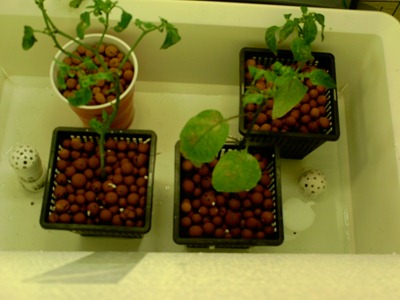
Though not my first hydroponic system this is is definitely a little more complicated than my last attempt of an fogger system created last year. This time I decided to go with an Ebb and Flow system, where the concept it pretty simple, flood the planting area with water nutrients and let it drain, wait a defined amount of time and then repeat. For this build I had a few requirements:
- Must be inexpensive: Hey this is the cheap vegetable gardener site
- Must be small: I have a limited space to grow and nutrients can be expensive and given what I am growing is legal don’t really need $20 basil
- Must be safe from flooding: Though this is running in my garage, I really don’t want to come in with 10/20 gallons of water/nutrients on my floor.
- Could be adapted for alternate hydroponic system.
Given these requirements, this is what I came up with and how I built it:
Materials
- 18 gallon opaque Rubbermaid container (happened to have one of these around
- 5 gallon basin — SLUGIS box from Ikea ($5.99)
- vinyl tape (plumbers tape)
- 1 inch hole saw
- 1 inch threaded (diameter) to 3/4 PVC adapter
- 3/4 inch threaded (diameter) to 1/2 in hose adapter
- 2 3/4 inch PVC caps
- Cheap pond/fountain pump (100 GPH)
- 1 foot of 1/2 inch plastic tubing
- 2 foot 3/4 inch PVC pipe (only need couple inches but smallest length I could buy)
- aquarium/food grade silicon (optional I used this to ensure very watertight seal but found not necessary)
Construction
Take the 5 gallon basin and drill two 1 inch holes in the middle of each side. One whole should be drilled from the top and the other should be drilled from the bottom.�
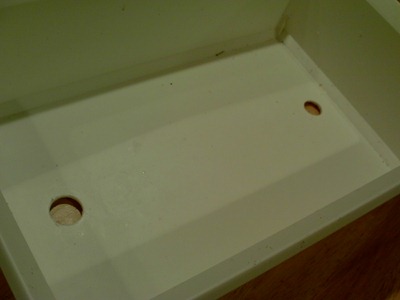
Take both threaded adapters and apply liberal amount of vinyl tape.
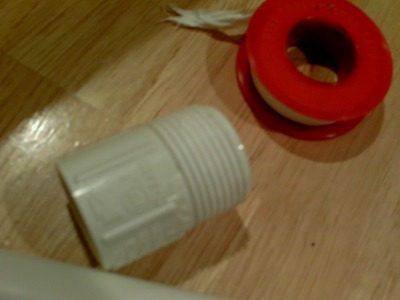
Screw in the 1/2 inch hose adapter from the bottom with just barely enough clearance to pop through. When the pump stops the water will drain through this same hole.
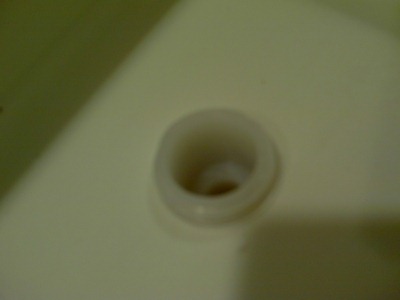
For the overflow pipe, screw in the 3/4 inch PVC adapter in from the top until hand tight.
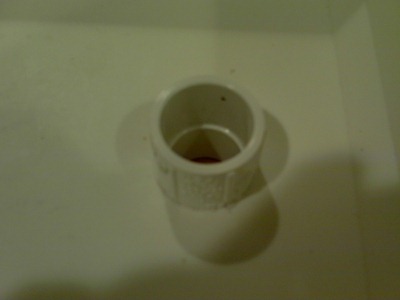
Take both caps and drill in a bunch of holes slightly smaller than your media. The basic idea is you don’t want some Hydroton clay balls falling into your pump or reservoir.
Cut about 2 inches of 3/4 PVC pipe and attach to overflow and top with PVC cap with dozen or so holes in it.

Lastly attach the 1/2 plastic tube to your pump and place everything on top of your 18 gallon Rubbermaid tub (which fits perfectly and is very sturdy) Fill with water nutrients and hook up your water pump to a 24 hour timer (or grow box controller)
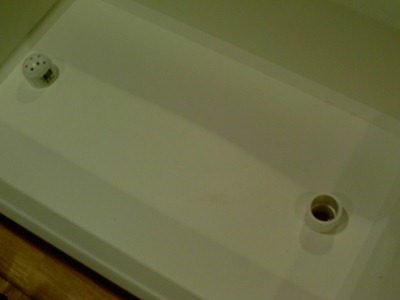

Here is the Ebb & Flow system in action, as you can see very simple but very cheap and versatile.
Tags: cheap, growbox, led, outdoor plants, vegetables
LED/Christmas light projects
Just a friendly reminder to pick up some discounted LED or non-LED Christmas lights for some of my previous projects
Christmas LED Grow Box
Basically take a old Rubbermaid container and drill some holes and insert lights and you have your own Christmas light LED grow box. This worked great last year to hold my seedlings until they were ready to move into the bigger grow box in the garage. Here are some posts on construction and updates:
Cheap LED Light and Grow Box
Christmas light LED grow box – Update #1
Christmas light LED grow box – Update #2
Supplemental Christmas LED Light
Similar idea to the LED grow box, though used in addition to your normal grow lights for a little additional red wavelength light, see posts below for complete construction directions:
Make your own supplemental LED grow light
Heating row tunnels (or grow box) with non-LED lights
Replacing your old Christmas lights with LEDs to save on your electricity bill? You can use your old regular old Christmas lights to heat your row tunnels to increase the temperature by about 10 degrees to help get your plants out a ahead of schedule. I have been using some of mine in my grow box to help during some of our colder nights this winter.
Heating row tunnels and grow box with Christmas lights
Tags: cheap, garden seeds, grow lights, growbox, led, outdoor plants, vegetables
Heating row tunnels and grow box with Christmas lights
14.4 years ago cheap, indoor growbox
Currently it is 16 degrees outside and given my grow box containing jalapeno peppers is in my unheated detached garage, which can bring some challenges. Like most plants, peppers will continue to grow in the range of 60 to 90 degrees, but thrive in 70 to 90 degrees. With the lights on the grow box gets to about 60 degrees but drips to the 50’s at night. This will result in plants having stunted growth and begin dropping blossoms before they can start bearing fruit.
My solution, a string of green mini Christmas lights. Just to clarify these are your typical small bulb Christmas lights not LEDs, given the efficiency of LEDs they do not product much extra heat which is what I am going for here. I also chose green Christmas lights because plants do not absorb this wavelength very well so they can be left on at night to keep heating while still letting the plants “sleep”.
Of course results will vary depending on the size of your grow box or outside row tunnel, insulation, and exterior temperature, but I am seeing 8-10 degree increase in temperature with a single string (50 bulbs)
I am always open to new ideas to safely, cheaply and efficiently heat my grow box or row tunnel so if anyone has any other suggestions please add a comment.
Tags: cheap, grow lights, growbox, led, outdoor plants, pepper plants
Best DIY cheap soil moisture sensor
14.5 years ago cheap, electronics, moisture sensor, water
My first version of my cheap soil moisture sensor has worked great for me but it did have a couple flaws. The first issue was construction, though I had great luck on my first attempt though after trying to recreate additional sensors given the small amount of gypsum between the sensor and the probes were so thin it was extremely easy to crack the sensor and I normally have about a 25% success rate on later creations (must have had beginners luck on the first one.
The second issue was durability. Given we are playing with gypsum and as it is suspended in water it will eventually breakdown and there is very little we can do about it. Though with my latest changes to my automated grow box which includes automated watering based on moisture content I want to ensure my measurements stay accurate throughout the season. To help with this I have decided to increase the sensors size and also am using galvanized nails to prevent rusting. After a few attempts I have come up what I feel is a pretty foolproof method of creating a moisture sensor.
How it works:
There were many questions in the comments in the previous post so hopefully I can clear this up a little here.
Technically a gypsum block measures soil water tension. When the gypsum block is dry it is not possible for electricity to pass between the probes, essentially making the probe an insulator with infinite resistance.
As water is added to the problem more electrons can pass between the probes effectively reducing the amount of resistance between the problem to the point when it is fully saturated where the probe has virtually zero resistance. By using this range of values you can determine the amount of water than exists in your soil.
Parts for cheap soil moisture sensor:
- Plaster of Paris
- 2 Galvanized Finish Nails
- 1/2 inch plastic tubing
- utility knife
Construction:
Take your utility knife and cut the tubing slightly longer than your galvanized finishing nails. Try to make the cut as straight as possible though it doesn’t have to be completely perfect.
Use your utility knife to cut the smaller plastic tube lengthwise, this will allow easier removal of your soil sensor after the mold cures.
Optional: Make the cut diagonally to prevent a potential vertical fracture line.
If you were very careful on you vertical cuts you can avoid this step, but to completely avoid spilling plaster onto my workbench I drilled four holes slightly larger than your tubing. I used these holes for support but also to catch any of the plaster in the gaps from you less than accurate vertical cuts.
Being careful that the tubing fits together where you split the tubing vertically, insert the tubes into the holes (or carefully on a flat surface) Mix Plaster of Paris and carefully fill with to the top. The friction between the tubing should keep a water tight seal where you made the cut, though if the plaster is a little thin and it appears to be leaking through wait a couple minute for the plaster to setup some and try again, at that time it should not have the viscosity to seep through the very small gap that may be causing the leak.
Take your two galvanized nails and push them through a small piece of wax paper. You may also allow the plaster to setup for a few minutes and then float the nails in the the plaster. I like the first method since gravity will help ensure they fall straight down and parallel to each other. As for spacing, I have done some experimentation with the gaps between the probes and my conclusion was, it doesn’t make much difference. As long as there is a gap (they are not touching) you should get reliable results.
After allowing the sensor to cure for about and hour remove it from the holes you drilled in the wood.
Gently pull back the plastic tubing and you have a nice clean soil sensor.
Lay them out to dry for 24 hours to cure completely and their construction is complete.
For attaching the wires there are a couple options. The best would be to solder them to the probes though to do this you need to heat up the nail hot enough to enable a strong solder connection. My little 15W soldering iron just can’t produce the heat for this so I am option for the wire wrap method. I take about an inch of wire and strip off about an inch of insulation and tightly wrap around the probe. Given copper will rust and could be a point of failure you will want to insulate this connection and the probes from the moisture. A few dabs of hot glue works pretty well. I am planning on trying liquid plastic, though I am currently out and when I have some on hand I will update with how it went.
How to use your cheap soil moisture sensor
You can simply hook up a multi-meter and check the resistance though if you want to create anything automated you would need to use an integrated circuit (IC) or a electronics prototyping platform such as Arduino. By applying voltage to one side of the sensor and using a voltage splitting circuit connected to ground and an analog input you can then measure the voltage making it through the probe. The higher the voltage, the higher the moisture content of the soil.
Conclusion
The above should give you everything you need to know to create your own cheap soil moisture sensor and how to use it. This can be used as a moisture soil sensor for watering your indoor plants like I am using it. This same moisture sensor could be for monitoring your outside soil moisture content to trigger (or preempt your irrigation system) to save some money on your water bill and/or maintain consistent moisture levels in your plants which could drastically improve water sensitive crops such as tomatoes.
Tags: arduino, cheap, growbox, led, outdoor plants, tomato plants, vegetables
Growing blueberries
14.6 years ago blueberry, cheap
If it were up to me every part of my landscaping would be edible. Though my homeowners association may disagree with me but blueberry bushes looks just as nice as any ornamental plant/bush when you visit the nursery with the obvious bonus of free food.
When selecting a blueberry bush, unless you are very patient spend about $10 a plant and get some more established ones (about 1/2 inch stem) You can get the two for $10 plants from your local Home Depot but you won’t be eating blueberries for a couple years. With the larger plants you should pinch off the blossoms to get better growth for the first couple years but I opt to getting my reward now instead of later and enjoy the handful of berries the young plants can produce.
When it comes to plant selection there are a large number of species to choose from with varying fruit size and harvest timing. I would recommend getting varieties that have varying maturity dates so you can enjoy those blueberries for a longer period of time. When I got my first two plants I went with Toro and Berkeley. The Berkeley is a very popular bush given it produces average size berries great for muffins/pancakes/cereal or the occasional snack with a mid-late harvest. The Toro on the other hand produces large (almost grape size) berries which are great for jams and snacks though bit of a mouthful for muffins. If you are curious of other varieties here is a great resource.
I have heard differing opinions on whether you need to have different species to successfully produce fruit after a little research I found this article which explains that blueberries are capable of pollinating with a single species, though studies have shown that having more varieties can produce larger and earlier fruits. So if you have a favorite variety you can go crazy with the single plant though a little diversity seems to always be a good thing.
When it comes to pest control the biggest pest is birds. You can control them by laying some netting on the plants, though in my personal opinion that just gets in the way of me getting my snacks so I opt for the lazy approach and just plant more plants and share with “neighbors”. Worse case I end up with a backyard with some bushes that look much nicer than my current evergreens, and I always can take up bird watching.
One of the most important parts to being successful with your little blueberry plants is soil preparation. The plants need to have an acidic soil and their roots like to remain moist, but not drowning in water. Given my area has an abundance of clay in my backyard, I naturally do not have either of these requirements. To give the plants a head start I dug a 1 foot wide/deep hole and filled it with peat moss and mixed with a few handfuls of compost. Not only will this retain water well, but the peat moss is also naturally acidic and will be a nice haven for a large family of worms in the next few years to add some awesome natural fertilizer (worm castings) Last I purchased I box of organic blueberry fertilizer which provides the primary and trace minerals as well as help keep the acidity of the soil up. I simply followed the directions on the box and watered the plants when there was a couple of days without rain.
Now some of you might be thinking, “hey it is fall why are you talking about growing blueberries” Well this is the “Cheap Vegetable Gardener, right now is a great time to visit your local nursery to pick up some of their “old overgrown” blueberry plants at bargain prices which you can plant now and enjoy some delicious berries next spring/summer.
Tags: birds, cheap, compost, led, organic vegetables, outdoor plants, vegetables, worms
